
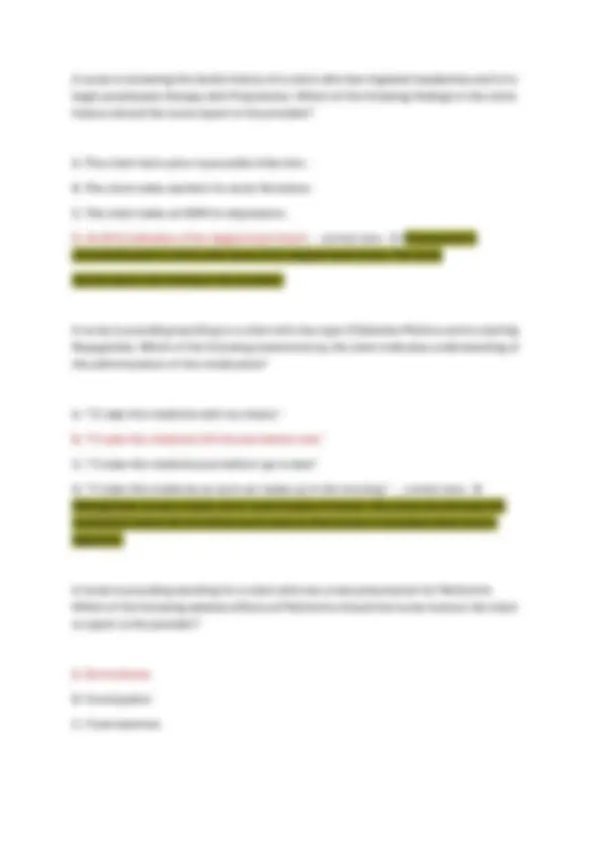
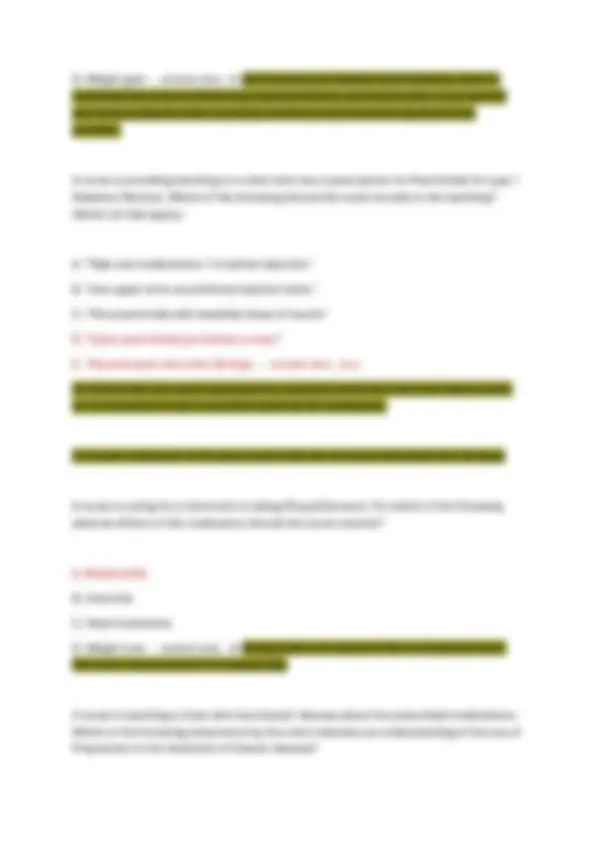
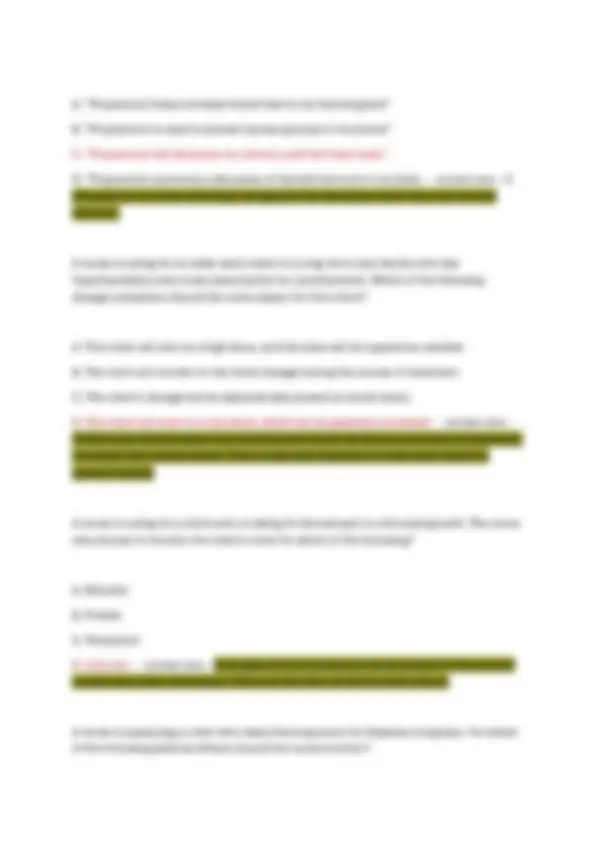
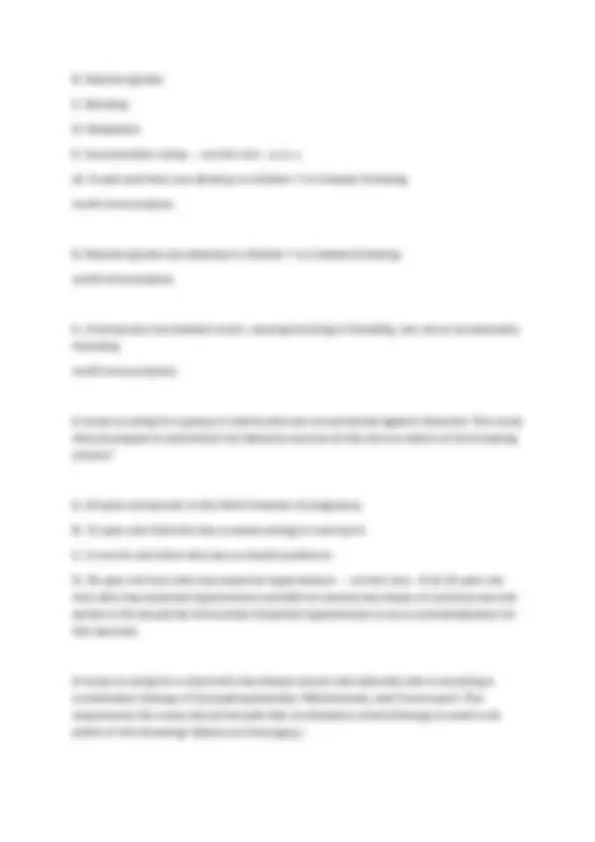
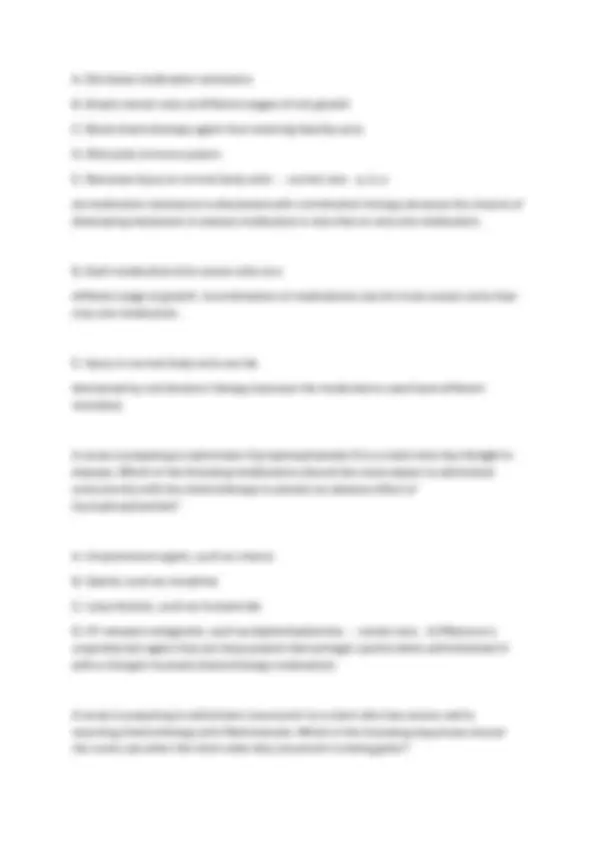
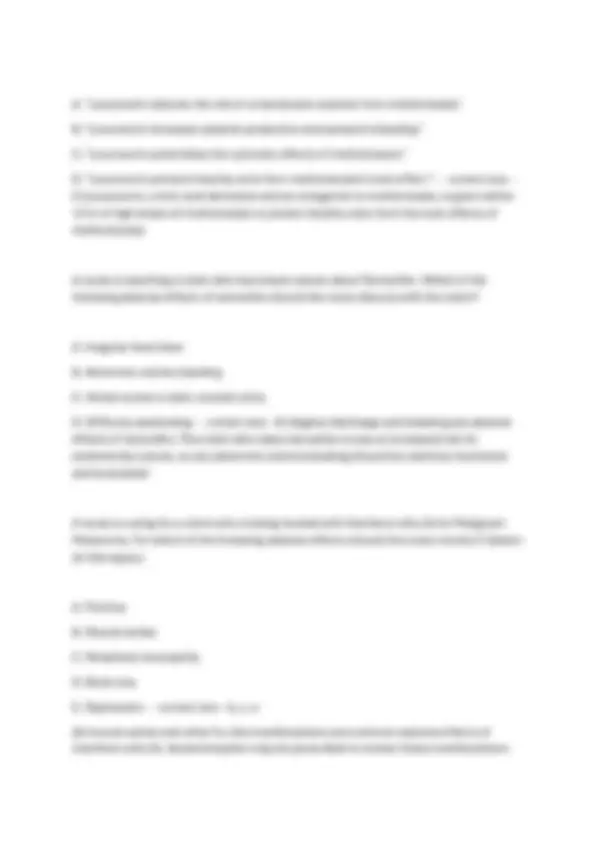
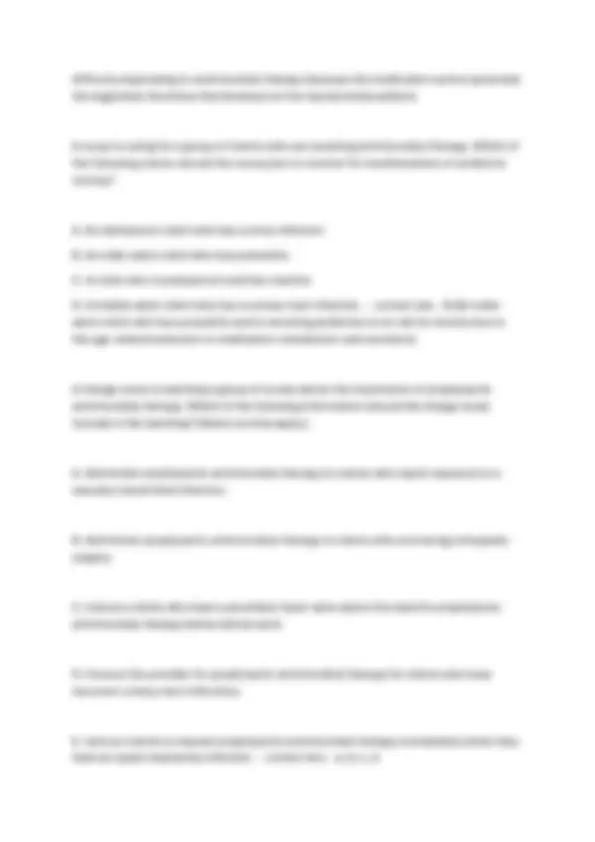
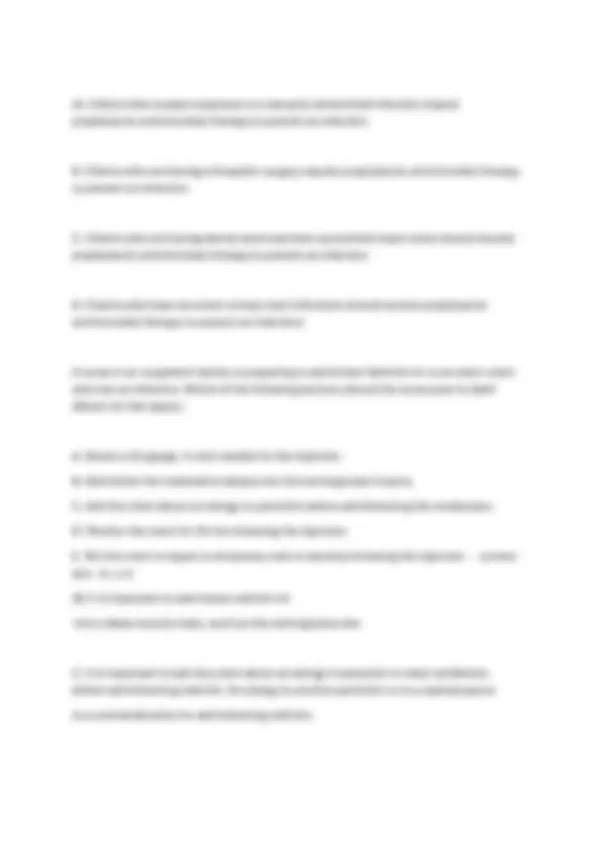
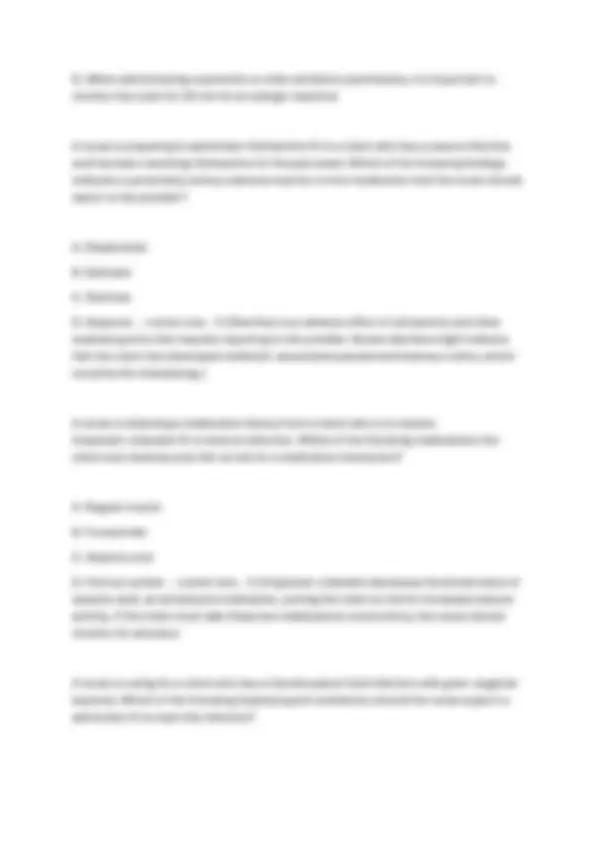
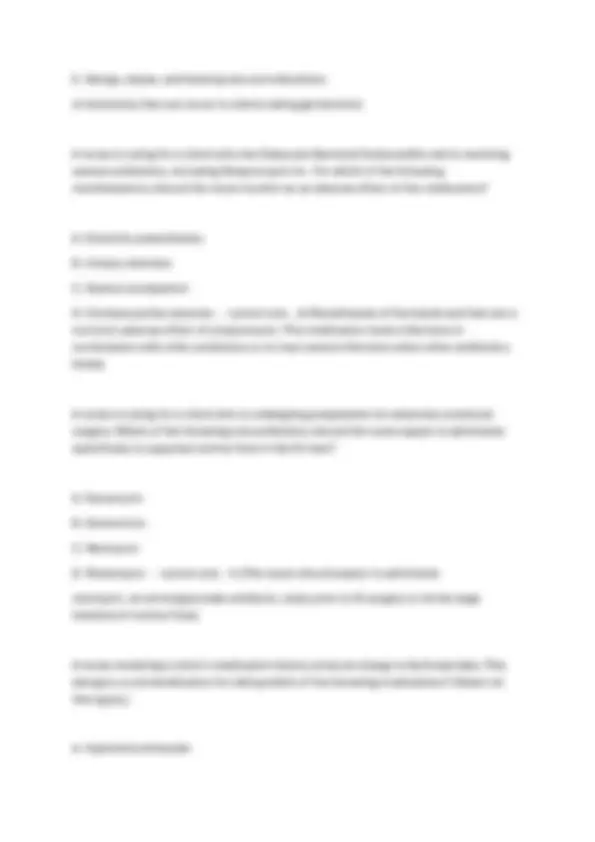
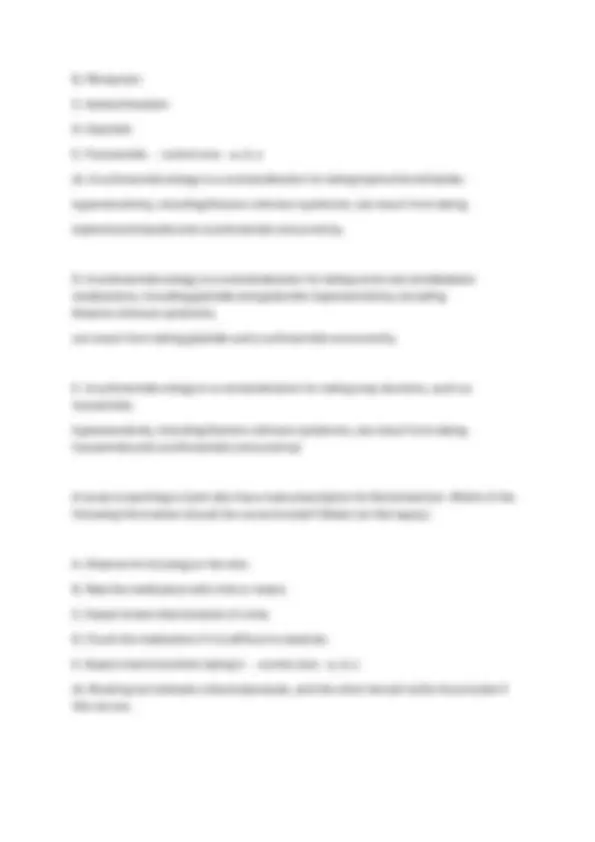
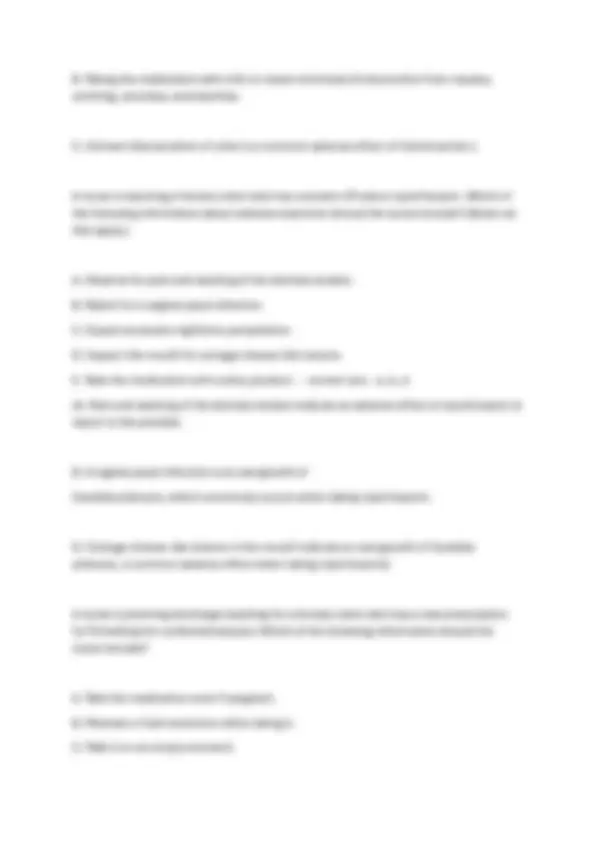
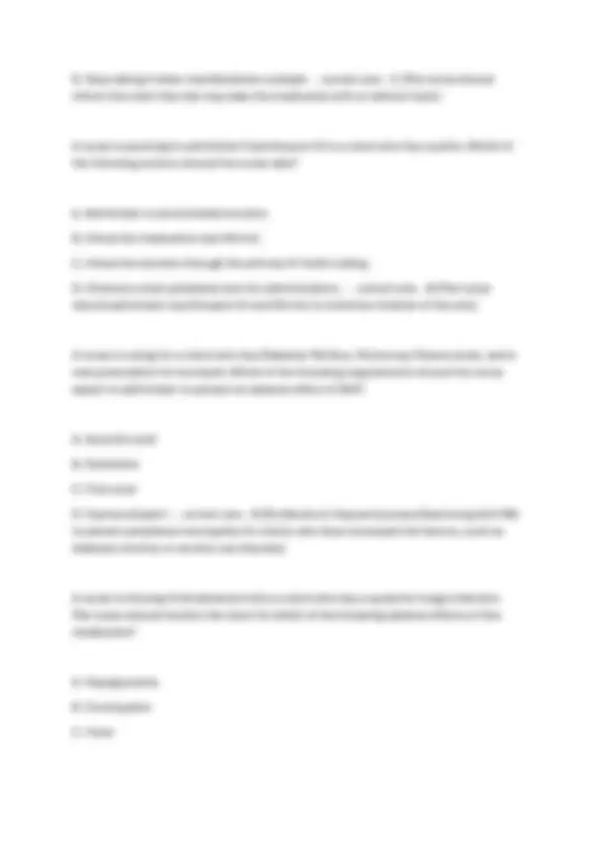
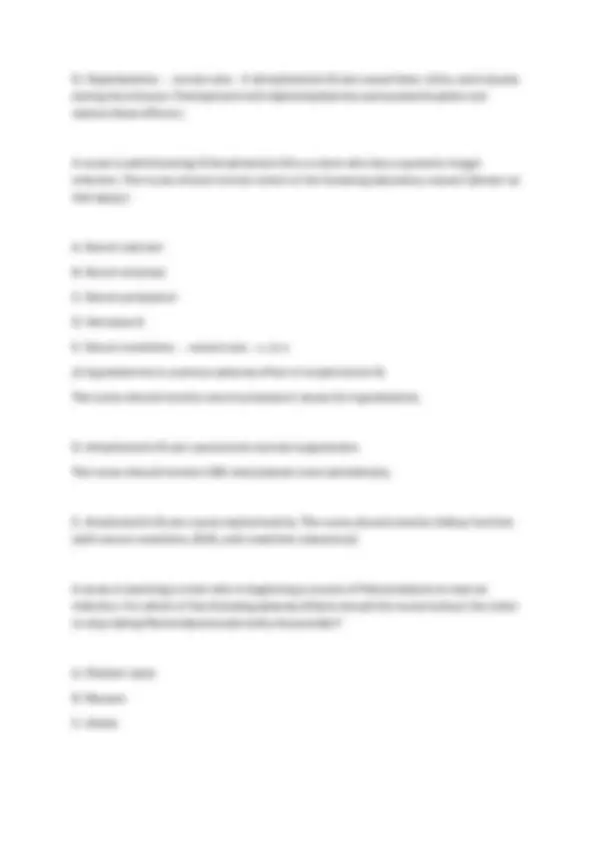
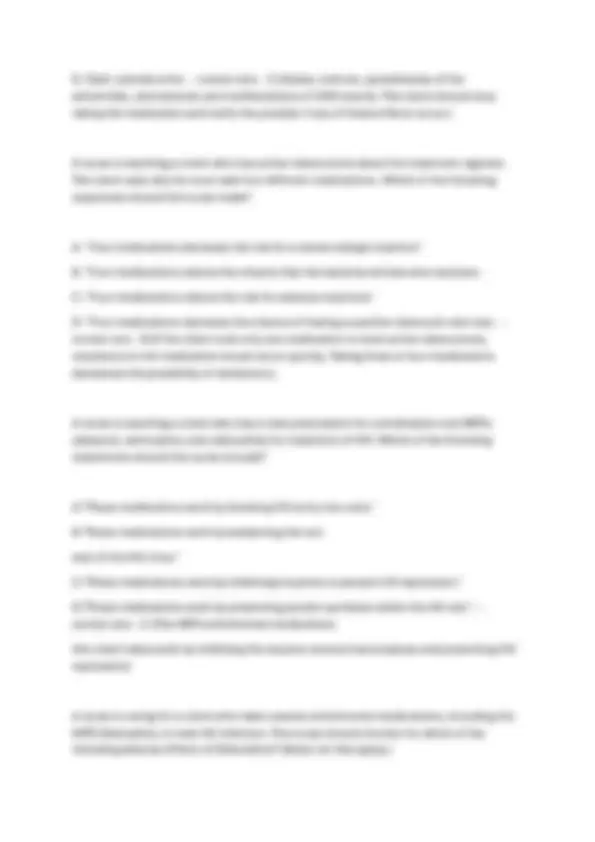
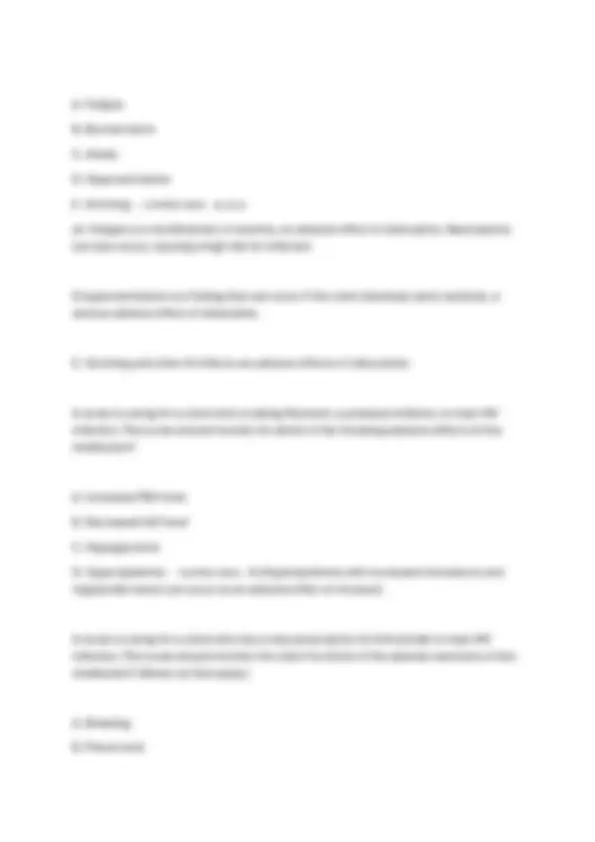
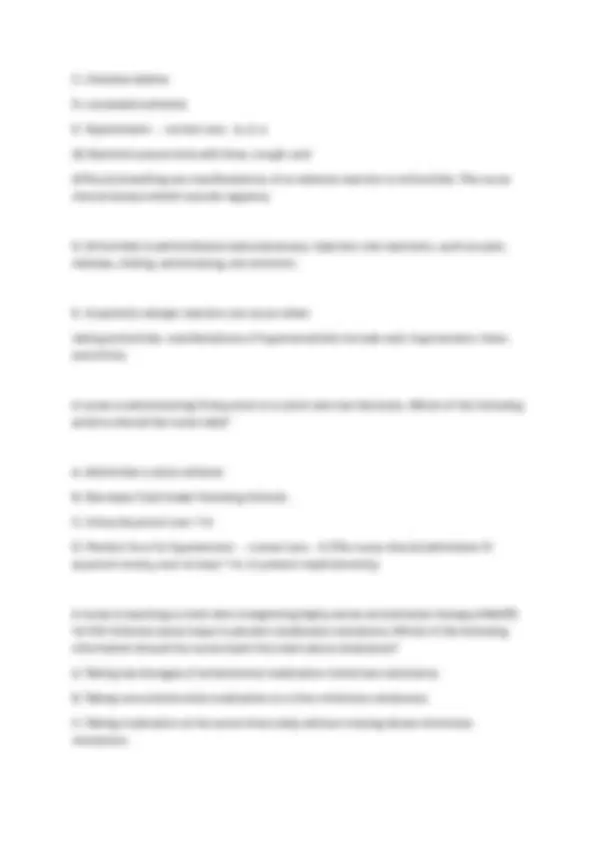



Study with the several resources on Docsity

Earn points by helping other students or get them with a premium plan


Prepare for your exams
Study with the several resources on Docsity

Earn points to download
Earn points by helping other students or get them with a premium plan
Community
Ask the community for help and clear up your study doubts
Discover the best universities in your country according to Docsity users
Free resources
Download our free guides on studying techniques, anxiety management strategies, and thesis advice from Docsity tutors
A.T.I Pharmacology Proctored Test Prep 2025 – Complete Practice Bundle with NCLEX-Style Questions, Evidence-Based Answers, and Proven Success Strategies for RN & LPN Students
Typology: Exams
1 / 26

This page cannot be seen from the preview
Don't miss anything!



















A nurse is providing teaching to a client who has migraine headaches and a new prescription for Ergotamine. For which of the following adverse effects should the nurse instruct the client to stop taking the medication and notify the provider? (Select all that apply.) A. Nausea B. Visual disturbances C. Positive home pregnancy test D. Numbness and tingling in fingers E. Muscle pain - - correct ans- - c, d, e (C. A client who has a positive home pregnancy test should stop taking ergotamine and notify the provider. Ergotamine is classified as Pregnancy Risk Category X and can cause fetal abortion. D. Numbness and tingling in fingers or toes can be a finding in ergotamine overdose. The medication should be stopped and the provider notified. E. Unexplained muscle pain can be a finding in ergotamine overdose. The medication should be stopped and the provider notified)
A nurse is teaching clients in an outpatient facility about the use of Insulin to treat type 1 Diabetes Mellitus. For which of the following types of insulin should the nurse tell the clients to expect a peak effect 1 to 5 hr after administration? A. Insulin glargine B. NPH insulin C. Regular insulin D. Insulin lispro - - correct ans- - C (Regular insulin has a peak effect around 1 to 5 hr following administration) A nurse is caring for a client in an outpatient facility who has been taking Acarbose for type 2 Diabetes Mellitus. Which of the following laboratory tests should the nurse plan to monitor? A. WBC B. Serum potassium C. Platelet count D. Liver function test - - correct ans- - D (Acarbose can cause liver toxicity when taken long-term. Liver function tests should be monitored periodically while the client takes this medication) A nurse is caring for a client who receives a local anesthetic of Lidocaine during the repair of a skin laceration. For which of the following adverse reactions should the nurse monitor the client? A. Seizures B. Tachycardia C. Hypertension D. Fever - - correct ans- - A (Seizure activity is an adverse effect that can occur as a result of local anesthetic injection.)
D. Weight gain - - correct ans- - A (Somnolence can indicate lactic acidosis, which is manifested by extreme drowsiness, hyperventilation, and muscle pain. It is a rare but very serious adverse effect caused by metformin and should be reported to the provider.) A nurse is providing teaching to a client who has a prescription for Pramlintide for type 1 Diabetes Mellitus. Which of the following should the nurse include in the teaching? (Select all that apply.) A. "Take oral medications 1 hr before injection." B. "Use upper arms as preferred injection sites." C. "Mix pramlintide with breakfast dose of insulin." D. "Inject pramlintide just before a meal." E. "Discard open vials after 28 days. - - correct ans- - d, e (D. Pramlintide can cause hypoglycemia, especially when the client also takes insulin, so it is important to eat a meal after injecting this medication. E.Unused medication in the open pramlintide vial should be discarded after 28 days) A nurse is caring for a client who is taking Propylthiouracil. For which of the following adverse effects of this medication should the nurse monitor? A. Bradycardia B. Insomnia C. Heat intolerance D. Weight loss - - correct ans- - A (Bradycardia is an adverse effect of propylthiouracil. The nurse should monitor for bradycardia) A nurse is teaching a client who has Graves' disease about her prescribed medications. Which of the following statements by the client indicates an understanding of the use of Propranolol in the treatment of Graves' disease?
A. "Propranolol helps increase blood flow to my thyroid gland." B. "Propranolol is used to prevent excess glucose in my blood." C. "Propranolol will decrease my tremors and fast heart beat." D. "Propranolol promotes a decrease of thyroid hormone in my body - - correct ans- - C (Propranolol is a beta-adrenergic antagonist that decreases heart rate and controls tremors.) A nurse is caring for an older adult client in a long-term care facility who has Hypothyroidism and a new prescription for Levothyroxine. Which of the following dosage schedules should the nurse expect for this client? A. The client will start at a high dose, and the dose will be tapered as needed. B. The client will remain on the initial dosage during the course of treatment. C. The client's dosage will be adjusted daily based on blood levels. D. The client will start on a low dose, which will be gradually increased - - correct ans- - D (The nurse should expect that levothyroxine will be started at a low dose and gradually increased over several weeks. This is especially important in older adult clients to prevent toxicity) A nurse is caring for a client who is taking for Somatropin to stimulate growth. The nurse should plan to monitor the client's urine for which of the following? A. Bilirubin B. Protein C. Potassium D. Calcium - - correct ans- - D (A large amount of calcium can be present in the urine of a client who takes somatropin. This puts the client at risk for renal calculi) A nurse is assessing a client who takes Desmopressin for Diabetes Insipidus. For which of the following adverse effects should the nurse monitor?
A nurse is teaching a group of new parents about immunizations. The nurse should instruct the parents that the series for which of the following vaccines is completed prior to the first birthday? A. Pneumococcal conjugate vaccine B. Meningococcal conjugate vaccine C. Varicella vaccine D. Rotavirus vaccine - - correct ans- - D (Rotavirus vaccine is administered only to infants less than 8 months, 0 days of age) A nurse at a provider's office is preparing to administer RV, DTaP, hib, PCV13, and IPV immunizations to a 4-month-old infant. Which of the following actions should the nurse plan to take? (Select all that apply.) A. Administer IPV orally B. Administer subcutaneous injections in the anterolateral thigh. C. Administer Im injections in the deltoid muscle. D. Give the infant his pacifier during vaccine injections. E. Teach parents to give aspirin on a schedule for 24 hr after immunization - - correct ans- - b, d (B. Subcutaneous immunizations may be administered in either the anterolateral thigh or the outer aspect of the upper arm to infants and children. D.Giving the infant a pacifier during injections is a comfort measure that should be encouraged by the nurse.) A 12-month-old child just received the first measles, mumps, and rubella (mmR) vaccine. For which of the following possible reactions to this vaccine should the nurse teach the parents to monitor? (Select all that apply.) A. Rash
B. Swollen glands C. Bruising D. Headache E. Inconsolable crying - - correct ans- - a, b, c (A. A rash and fever can develop in children 1 to 2 weeks following mmR immunization. B. Swollen glands can develop in children 1 to 2 weeks following mmR immunization. C. A temporary low platelet count, causing bruising or bleeding, can occur occasionally following mmR immunization) A nurse is caring for a group of clients who are not protected against Varicella. The nurse should prepare to administer the Varicella vaccine at this time to which of the following clients? A. 24-year-old woman in the third trimester of pregnancy B. 12-year-old child who has a severe allergy to neomycin C. 2-month-old infant who has no health problems D. 32-year-old man who has essential hypertension - - correct ans- - D (A 32-year-old man who has essential hypertension and did not receive two doses of varicella vaccine earlier in life should be immunized. Essential hypertension is not a contraindication for this vaccine) A nurse is caring for a client who has breast cancer and asks why she is receiving a combination therapy of Cyclophosphamide, Methotrexate, and Fluorouracil. The response by the nurse should include that combination chemotherapy is used to do which of the following? (Select all that apply.)
A. "Leucovorin reduces the risk of a transfusion reaction from methotrexate." B. "Leucovorin increases platelet production and prevents bleeding." C. "Leucovorin potentiates the cytotoxic effects of methotrexate." D. "Leucovorin protects healthy cells from methotrexate's toxic effect." - - correct ans- - D (Leucovorin, a folic acid derivative and an antagonist to methotrexate, is given within 12 hr of high doses of methotrexate to protect healthy cells from the toxic effects of methotrexate) A nurse is teaching a client who has breast cancer about Tamoxifen. Which of the following adverse effects of tamoxifen should the nurse discuss with the client? A. Irregular heart beat B. Abnormal uterine bleeding C. Yellow sclera or dark-colored urine. D. Difficulty swallowing - - correct ans- - B (Vaginal discharge and bleeding are adverse effects of tamoxifen. The client who takes tamoxifen is also at increased risk for endometrial cancer, so any abnormal uterine bleeding should be carefully monitored and evaluated) A nurse is caring for a client who is being treated with Interferon alfa-2b for Malignant Melanoma. For which of the following adverse effects should the nurse monitor? (Select all that apply.) A. Tinnitus B. Muscle aches C. Peripheral neuropathy D. Bone loss E. Depression - - correct ans- - b, c, e (B.muscle aches and other flu-like manifestations are common adverse effects of interferon alfa-2b. Acetaminophen may be prescribed to relieve these manifestations.
C. Peripheral neuropathy, dizziness, and fatigue are CNS effects that can occur when taking interferon alfa-2b. These should be reported to the provider, and the nurse should teach the client to prevent injury from falls. E. Depression and mental status changes can occur with interferon alfa-2b treatment. The nurse should assess the client for suicidal thoughts.) A nurse is caring for a client who receives Rituximab to treat Non-hodgkin's Leukemia and who asks the nurse how Rituximab works. Which of the following should the nurse include? A. Blocks hormone receptors B. Increases immune response C. Binds with specific antigens on tumor cells D. Stops DNA replication during cell division - - correct ans- - C (Rituximab is a monoclonal antibody that binds to specific antigens on B-lymphocytes and then destroying cancer cells.) A nurse is implementing a plan of care for a client who has a wound infection. Which of the following actions should the nurse perform first? A. Administer antibiotic medication. B. Obtain a wound specimen for culture. C. Review WBC laboratory findings. D. Apply a dressing to the wound - - correct ans- - B (When using the urgent vs. nonurgent approach to care, the nurse's priority action is to obtain a culture of the wound before initiating antibiotic therapy)
difficulty responding to antimicrobial therapy because the medication cannot penetrate the vegetative thrombus that develops on the injured endocardium) A nurse is caring for a group of clients who are receiving antimicrobial therapy. Which of the following clients should the nurse plan to monitor for manifestations of antibiotic toxicity? A. An adolescent client who has a sinus infection B. An older adult client who has prostatitis C. A client who is postpartum and has mastitis D. A middle adult client who has a urinary tract infection - - correct ans- - B (An older adult client who has prostatitis and is receiving antibiotics is at risk for toxicity due to the age-related reduction in medication metabolism and excretion) A charge nurse is teaching a group of nurses about the importance of prophylactic antimicrobial therapy. Which of the following information should the charge nurse include in the teaching? (Select all that apply.) A. Administer prophylactic antimicrobial therapy to clients who report exposure to a sexually transmitted infection. B. Administer prophylactic antimicrobial therapy to clients who are having orthopedic surgery. C. Instruct clients who have a prosthetic heart valve about the need for prophylactic antimicrobial therapy before dental work. D. Consult the provider for prophylactic antimicrobial therapy for clients who have recurrent urinary tract infections. E. Instruct clients to request prophylactic antimicrobial therapy immediately when they have an upper respiratory infection - - correct ans- - a, b, c, d
(A. Clients who suspect exposure to a sexually transmitted infection require prophylactic antimicrobial therapy to prevent an infection. B. Clients who are having orthopedic surgery require prophylactic antimicrobial therapy to prevent an infection. C. Clients who are having dental work and have a prosthetic heart valve should receive prophylactic antimicrobial therapy to prevent an infection. D. Clients who have recurrent urinary tract infections should receive prophylactic antimicrobial therapy to prevent an infection) A nurse in an outpatient facility is preparing to administer Nafcillin Im to an adult client who has an infection. Which of the following actions should the nurse plan to take? (Select all that apply.) A. Select a 25-gauge, ½-inch needle for the injection. B. Administer the medication deeply into the ventrogluteal muscle. C. Ask the client about an allergy to penicillin before administering the medication. D. Monitor the client for 30 min following the injection. E. Tell the client to expect a temporary rash to develop following the injection - - correct ans- - b, c, d (B. It is important to administer nafcillin Im into a deep muscle mass, such as the ventrogluteal site. C. It is important to ask the client about an allergy to penicillin or other antibiotics before administering nafcillin. An allergy to another penicillin or to a cephalosporin is a contraindication for administering nafcillin.
A. Cefaclor B. Cefazolin C. Cefepime D. Cephalexin - - correct ans- - C (Cefepime, a fourth-generation cephalosporin, is more likely to be effective against this infection than the other medications, which are from the first or second generation. medications from each progressive generation of cephalosporins are more effective against gram-negative bacteria, more resistant to destruction by beta-lactamase, and more able to reach cerebrospinal fluid) A nurse is preparing to administer Penicillin V to a client who has a streptococcal infection. The client tells the nurse that she has difficulty swallowing tablets and doesn't "do well" with liquid or chewable medications because the taste gags her, even when the a nurse mixes the medication with food. The nurse should request a prescription for which of the following medications? A. Fosfomycin B. Amoxicillin C. Nafcillin D. Cefaclor - - correct ans- - C (Nafcillin is an acceptable alternative within the penicillin classification because it is available for Imor IV use.) A nurse is teaching a client about taking Tetracycline to treat a GI infection due to Helicobacter pylori, Which of the following statements should the nurse identify as an indication that the client understands the instructions? A. "I will take this medication with 8 ounces of milk." B. "I will let my doctor know if I start having diarrhea." C. "I can stop taking this medication when I feel completely well." D. "I can take this medication just before bedtime. - - correct ans- - B (Diarrhea can indicate that the client is developing a suprainfection, which can be very serious. The client should notify the provider if diarrhea occurs.)
A nurse is administering gentamicin by IV infusion at 0900. The medication will take 1 hr to infuse. When should the nurse plan to obtain a blood sample for a peak serum level of gentamicin? A. 1000 B. 1030 C. 1100 D. 1130 - - correct ans- - B (The nurse should obtain the blood specimen for the peak serum level at 1030, 30 min after the end of the IV infusion. For the trough level, the nurse should collect the blood sample just before starting the infusion) A nurse is caring for a client who is starting a course of gentamicin IV for a serious respiratory infection. For which of the following manifestations should the nurse monitor as an adverse effect of this medication? (Select all that apply.) A.Pruritus B. Hematuria C. Muscle weakness D. Difficulty swallowing E. Vertigo - - correct ans- - a, b, c, e (A. Paresthesias of the hands and feet, urticaria, rash, and pruritus are indications of a hypersensitivity reaction that can occur in clients taking gentamicin. B.hematuria is an indication of acute kidney toxicity due to gentamicin. C.muscle weakness and respiratory depression can occur in clients taking gentamicin as a result of neuromuscular blockade
B. Metoprolol C. Acetaminophen D. Glipizide E. Furosemide - - correct ans- - a, d, e (A. A sulfonamide allergy is a contraindication for taking hydrochlorothiazide. hypersensitivity, including Stevens-Johnson syndrome, can result from taking hydrochlorothiazide and a sulfonamide concurrently. D. A sulfonamide allergy is a contraindication for taking some oral antidiabetes medications, including glipizide and glyburide. hypersensitivity, including Stevens-Johnson syndrome, can result from taking glipizide and a sulfonamide concurrently. E. A sulfonamide allergy is a contraindication for taking loop diuretics, such as furosemide. hypersensitivity, including Stevens-Johnson syndrome, can result from taking furosemide and a sulfonamide concurrently) A nurse is teaching a client who has a new prescription for Nitrofurantoin. Which of the following information should the nurse include? (Select all that apply.) A. Observe for bruising on the skin. B. Take the medication with milk or meals. C. Expect brown discoloration of urine. D. Crush the medication if it is difficult to swallow. E. Expect insomnia when taking it - - correct ans- - a, b, c (A. Bruising can indicate a blood dyscrasia, and the client should notify the provider if this occurs.
B. Taking the medication with milk or meals minimizes GI discomfort from nausea, vomiting, anorexia, and diarrhea. C. A brown discoloration of urine is a common adverse effect of nitrofurantoin.) A nurse is teaching a female client who has a severe UTI about ciprofloxacin. Which of the following information about adverse reactions should the nurse include? (Select all that apply.) A. Observe for pain and swelling of the Achilles tendon. B. Watch for a vaginal yeast infection. C. Expect excessive nighttime perspiration. D. Inspect the mouth for cottage cheese-like lesions. E. Take the medication with a dairy product - - correct ans- - a, b, d (A. Pain and swelling of the Achilles tendon indicate an adverse effect of ciprofloxacin to report to the provider. B. A vaginal yeast infection is an overgrowth of Candida albicans, which commonly occurs when taking ciprofloxacin. D. Cottage cheese-like lesions in the mouth indicate an overgrowth of Candida albicans, a common adverse effect when taking ciprofloxacin) A nurse is planning discharge teaching for a female client who has a new prescription for Trimethoprim-sulfamethoxazole. Which of the following information should the nurse include? A. Take the medication even if pregnant. B. Maintain a fluid restriction while taking it. C. Take it on an empty stomach.